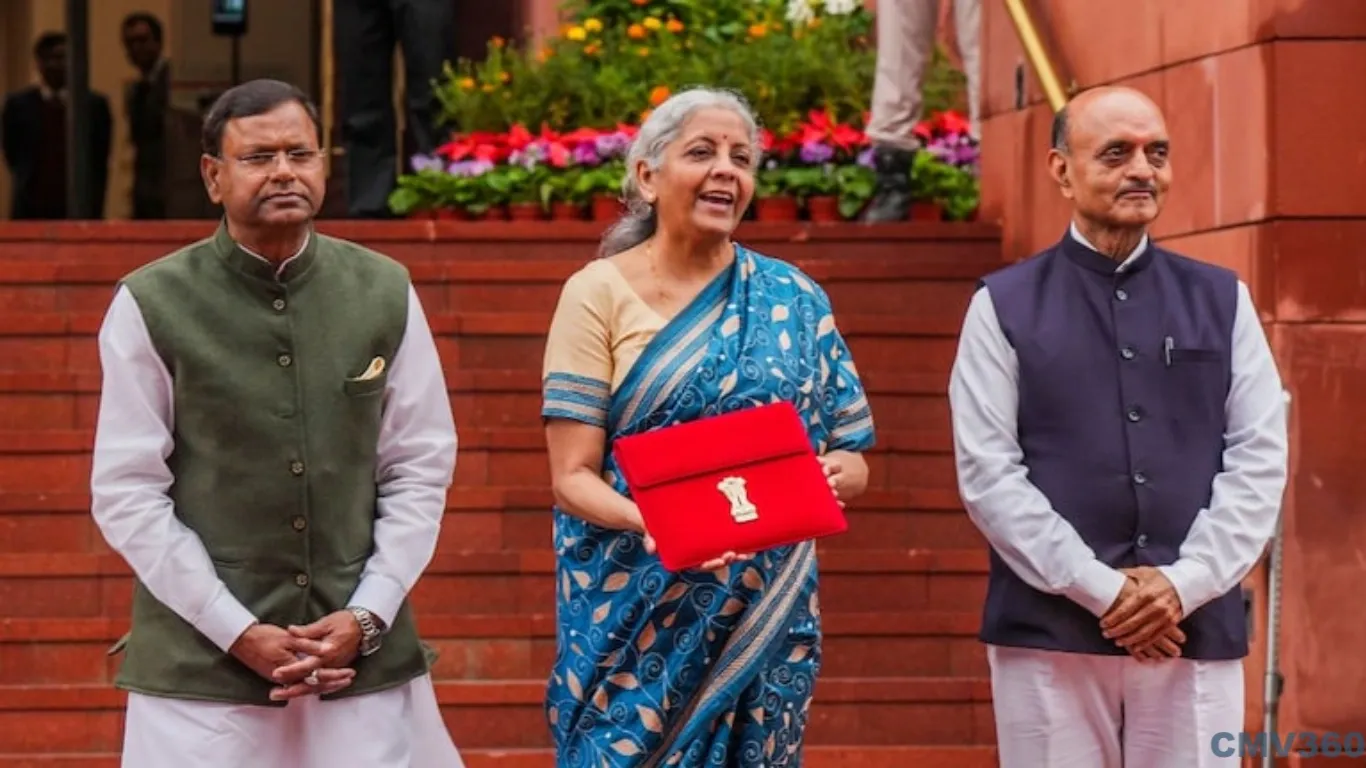Ad
Ad
Budget 2025 Updates: Big Announcements for Farmers and Agriculture Sector

On February 1, 2025, Hon'ble Finance Minister Nirmala Sitharaman presented the Indian Budget 2025 in Parliament. This marked her record 8th budget presentation, focusing on employment generation, agriculture, and infrastructure development. The budget prioritizes rural and agricultural growth while addressing tax-related issues. Here are the key announcements and their impact on farmers and the agriculture sector.
Key Announcements in Union Budget 2025
- Focus on Self-Sufficiency in Pulses: The government aims to achieve self-sufficiency in pulse crops across 100 districts. A six-year mission has been launched to boost pulse production and reduce dependency on imports.
- Prime Minister's Dhan-Dhanya Agriculture Scheme: This new scheme will promote agriculture, investment, MSMEs, and exports, benefiting farmers and rural economies.
- Makhana Board for Bihar: A dedicated Makhana Board will be established in Bihar to enhance production, value addition, and marketability of Makhana (fox nuts).
- Increased Kisan Credit Card (KCC) Limit: The KCC loan limit has been raised from ₹3 lakh to ₹5 lakh, benefiting 1.7 crore farmers.
- National Seed Mission: A National Seed Mission will be launched to improve seed quality and availability, ensuring higher crop yields.
- Urea Production Centre in Assam: A new urea production centre will be established in Assam to meet fertilizer demands and reduce costs for farmers.
- Five-Year Cotton Productivity Mission: The mission aims to promote long-staple cotton varieties, enhancing India's textile industry and farmers' income.
- Commercial Purchase Program for Fruits and Vegetables: A new program will ensure better prices for farmers by facilitating commercial purchases of fruits and vegetables.
- Support for Women and Rural Youth: A new scheme targeting 5 lakh women and small farmers will be introduced, focusing on skill development and income generation.
- Leather and Toy Industries: The leather industry will receive support to create new jobs, while a strategy to make India a global toy hub will boost small-scale industries.
- Saksham Anganwadi and Nutrition 2.0: This scheme aims to improve nutrition and healthcare for rural communities, indirectly supporting farming families.
- AI and Technology Focus: ₹500 crores have been allocated for an AI centre to promote technological advancements in agriculture and other sectors.
- Support for Street Vendors: The budget emphasizes increasing the income of 68 lakh street vendors, many of whom rely on agricultural produce.
- Jal Jeevan Mission Extended: The mission has been extended till 2028 to ensure water reaches every home.
- Special Credit Card for Small Industries: 10 lakh credit cards will be issued in the first year to support small industries.
- Increase in Medical Seats: 75,000 medical seats will be added over the next five years.
- Credit Guarantee Cover Increase: The credit guarantee cover will be increased from ₹5 crore to ₹10 crore.
- India Post Transformation: India Post will be transformed into a large public logistics organisation.
- Nuclear Energy Mission: A ₹20,000 crore mission will focus on nuclear energy development.
- Maritime Development Fund: A ₹25,000 crore fund will be established for maritime development.
- Cancer Hospitals: A cancer hospital will be established in every state.
- Homestay Loans: The government will provide loans for homestay businesses.
- Simplified Visa Rules: Visa rules will be simplified to promote tourism and business.
- Fund of Funds for Startups: A new Fund of Funds will be launched to support startups.
- New Airports: 120 new airports will be built over the next 10 years.
- Housing for All: Efforts will be made to provide housing to everyone.
- Modernization of Land Records: Land records will be modernized to improve transparency and efficiency.
- Focus on Solar Products: The government will focus on manufacturing solar products.
- Development of Buddhist Sites: Places related to Lord Buddha will be developed.
- Prime Minister Gatishakti Port: A new port will be built under the Gatishakti initiative.
- Bharat Tradenet for International Trade: A new platform will be established to facilitate international trade.
- New Income Tax Bill: A new income tax bill will be introduced in Parliament next week.
- Increased Foreign Investment in Insurance: The foreign investment limit in the insurance sector has been increased from 74% to 100%.
- Tech Research Fellowships: 10,000 fellowships will be given for tech research.
- Custom Duty Abolished on Medicines: Custom duty has been completely abolished on 36 life-saving medicines.
- Cheaper Indian Clothes: Clothes made in India will become cheaper.
- Cheaper Mobile Phones and EVs: Mobile phones and electric vehicles will become cheaper.
- E-Shram Portal: A new E-shram portal will be formed.
- Tariff Rate Reduction: Seven tariff rates will be removed.
- Duty-Free Medicines: 36 medicines for serious diseases are now duty-free.
- Increased Senior Citizen Tax Exemption: The tax exemption limit for senior citizens has been increased from ₹50,000 to ₹1 lakh.
- Reduction in TDS and TCS: Reductions in TDS and TCS will provide relief from inflation.
- Increased TDS Limit on Rent: The TDS limit on rent has been increased from ₹2.4 lakh to ₹6 lakh.
- Tax-Free National Savings Scheme Withdrawals: Withdrawals made from the National Savings Scheme after August 2024 will not be taxed.
- Increased Income Tax Exemption Limit: The income tax exemption limit has been raised to ₹12 lakh.
- Tax Rates: 15% tax on income between ₹12 lakh and ₹16 lakh, and 25% tax on income between ₹16 lakh and ₹20 lakh.
Also Read: Mustard Prices Rise: Rates Touch ₹6200 Per Quintal – Market Trends & Future Outlook
Prospects for Farmers and Agriculture in Budget 2025
Agriculture is the backbone of India's economy, supporting a large portion of the population. The government has taken several steps to address farmers' challenges and boost the sector:
- Increase in Minimum Support Price (MSP): The MSP for major crops is expected to rise, ensuring fair prices and higher incomes for farmers.
- Reduction in Interest Rates on Agricultural Loans: Lower interest rates on farm loans will reduce costs and improve farmers' financial stability.
- Promotion of Agri-Based Industries: Incentives for agriculture-based industries will increase demand for farm products, boosting exports from 50 billion to 80 billion by 2030.
- GST Relief on Farming Inputs: Farmers may receive GST relief on seeds, pesticides, and other inputs, reducing their expenses.
- Focus on Agricultural Research and Development: Increased funding for R&D will lead to innovative farming techniques and higher productivity.
- Higher Installments for Kisan Samman Nidhi: The annual installment under the PM-KISAN scheme may increase from ₹6,000 to ₹12,000, providing direct financial support to farmers.
Also Read: General Budget 2025: PM Kisan Samman Nidhi Yojana Amount Expected to Double
- Strengthening Crop Insurance Schemes: Agricultural insurance schemes will be expanded to protect farmers from losses due to natural disasters.
- Development of Agricultural Infrastructure: Investments in storage houses, cold chains, and transportation will help farmers get better prices for their produce.
CMV360 Says
The Indian government plans to invest an additional $20 billion in the agriculture sector in Budget 2025. This investment will focus on high-yield seeds, improved storage infrastructure, and increased production of oilseeds, vegetables, and dairy products. These measures aim to boost farmers' incomes, control inflation, and strengthen the agricultural economy.
With a strong emphasis on rural development, self-sufficiency, and farmer welfare, Budget 2025 is set to bring significant benefits to the agriculture sector and contribute to India's overall economic growth.
News
Goodyear Plans to Sell Farm Tyre Business in India, Valued at ₹2,700 Crore
Goodyear plans to sell its farm tyre business in India, valuing it at ₹2,700 crore under a strategic review....
23-Apr-25 11:37 AM
Read Full NewsMahindra Tractors Begins ‘Ashwamedh’ Journey Under ‘Rag Rag Laal Hai’ Campaign
Mahindra Tractors launches Ashwamedh journey under Rag Rag Laal Hai campaign, celebrating 40 years of leadership and farmer connections....
22-Apr-25 10:55 AM
Read Full NewsGangamai Industries and Mahindra Launch AI-Based Sugarcane Harvesting in Maharashtra
Gangamai partners with Mahindra to launch AI-based sugarcane harvesting in Maharashtra, improving yield, efficiency, and farmer benefits....
22-Apr-25 06:39 AM
Read Full NewsMahindra Group Reshuffles Key Leadership Roles: Hemant Sikka to Lead Mahindra Logistics
Mahindra reshuffles top leadership; Hemant Sikka to lead Mahindra Logistics, with key changes across automotive and farm sectors....
22-Apr-25 04:53 AM
Read Full NewsGood News: Deadline Extended for Subsidy on Agricultural Equipment in Madhya Pradesh
Madhya Pradesh has extended the subsidy application date for farm equipment to April 16, helping more farmers access machinery at a lower cost....
10-Apr-25 09:25 AM
Read Full NewsSwaraj Tractors Rejoins Hands with MS Dhoni as Brand Endorser
Swaraj Tractors partners again with MS Dhoni to promote modern farming, connect with youth, and support Indian agriculture....
09-Apr-25 07:01 AM
Read Full NewsAd
Ad
Latest Articles

Thinking of Buying a Second Hand Tractor? Read These Top 10 Important Tips
14-Apr-2025

Comprehensive Guide to Tractor Transmission System: Types, Functions, and Future Innovations
12-Mar-2025

Modern Tractors and Precision Farming: Transforming Agriculture for Sustainability
05-Feb-2025

Top 10 Tractors Under 30 HP in India 2025: Guide
03-Feb-2025

New Holland 3630 TX Super Plus vs Farmtrac 60 PowerMaxx: Detailed Comparison
15-Jan-2025

Swaraj 735 FE Vs Eicher 380 2WD Prima G3: Detailed Comparison
14-Jan-2025
View All Articles
As featured on:


Registered Office Address
Delente Technologies Pvt. Ltd.
M3M Cosmopolitan, 12th Cosmopolitan,
Golf Course Ext Rd, Sector 66, Gurugram, Haryana
pincode - 122002



















